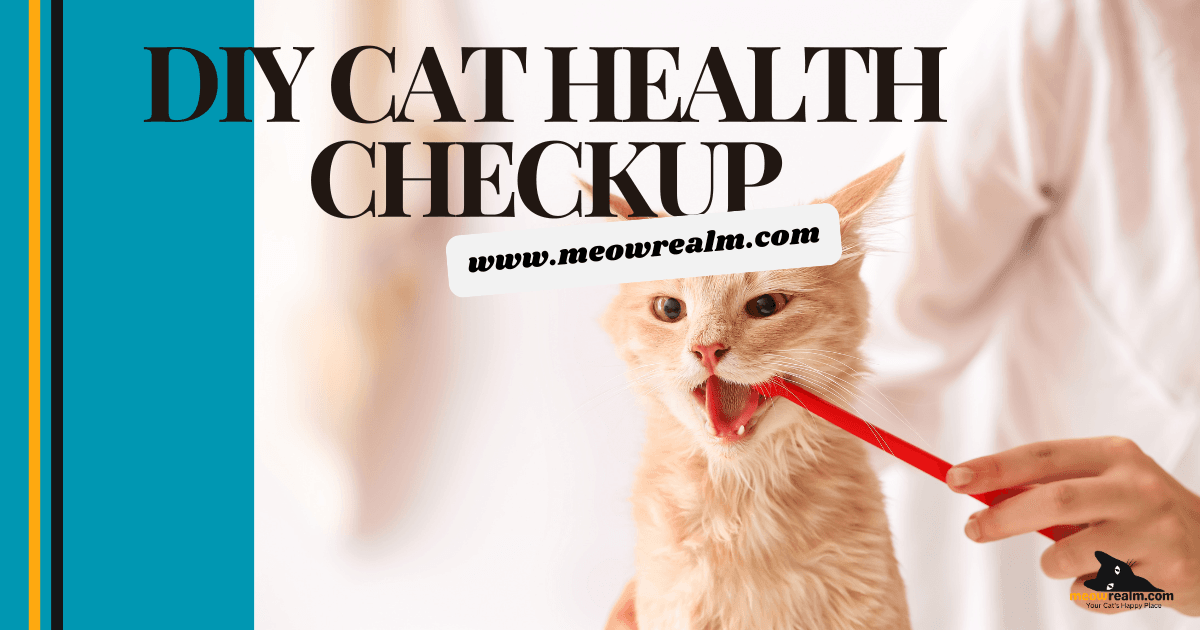A DIY cat health checkup is an essential part of ensuring your cat’s overall wellbeing. Learning how to conduct a basic health checkup at home can help you identify early signs of illness, allowing you to take action before conditions worsen. This guide will take you through the steps to perform a comprehensive DIY cat health checkup, covering everything from checking your cat’s eyes and ears to evaluating its weight and overall behavior.
Why Perform a DIY Cat Health Checkup?
Regular DIY cat health checkups are crucial for monitoring your cat’s health, particularly as cats are known for hiding symptoms of illness. By learning how to conduct a DIY health assessment, you can keep track of your cat’s condition and potentially catch problems early. A DIY cat health checkup also helps you build a better understanding of your pet’s body, which can make it easier to spot unusual changes.
Step-by-Step Guide for a DIY Cat Health Checkup
1. Eye Examination
The eyes are windows to your cat’s health, and a DIY cat health checkup should always include an eye examination. Your cat’s eyes should be clear, bright, and free from any discharge. Look for any redness, cloudiness, or signs of discomfort. Excessive tearing or changes in pupil size may indicate an underlying problem.
2. Ear Check
During a DIY cat health checkup, take a moment to check your cat’s ears. Healthy ears should be clean, without a strong odor or discharge. Look out for signs of wax buildup, redness, or an unpleasant smell, as these can signal ear infections or mites. Gently feel around the base of the ears for any swelling or lumps.
3. Mouth and Teeth Inspection
Dental health is an important aspect of any DIY cat health checkup. Examine your cat’s gums, teeth, and tongue. The gums should be pink, and there shouldn’t be any signs of swelling, redness, or bad breath. Excessive drooling or difficulty chewing can indicate oral health issues that may need veterinary attention.
4. Skin and Coat Condition
A DIY cat health checkup is incomplete without assessing the condition of your cat’s skin and coat. The coat should be shiny, soft, and free from bald patches. Run your hands over your cat’s body to feel for any unusual lumps, bumps, or scabs. Check for signs of fleas, such as black specks (flea dirt) or visible parasites.
5. Nose Examination
Your cat’s nose should be moist, but not overly wet, and free of any unusual discharge. As part of your DIY cat health checkup, ensure there are no cracks or sores on the nose. A runny nose or nasal discharge might indicate an upper respiratory infection or other health concerns.
6. Weight and Body Condition
Evaluating your cat’s weight is another key aspect of a DIY cat health checkup. Check for sudden weight gain or loss by feeling along the cat’s ribs and spine. You should be able to feel the ribs but not see them. Any noticeable changes in weight or appetite warrant a discussion with your veterinarian.
7. Paw and Nail Health
Don’t forget your cat’s paws and nails during the DIY health checkup. Examine the pads for cuts or cracks, and make sure the nails are trimmed properly. Long or ingrown nails can cause pain and affect your cat’s movement. Check between the toes for any foreign objects or signs of infection.
8. Behavior and Activity Level
Behavior is often an indicator of a cat’s health. A DIY cat health checkup should also involve observing your cat’s overall behavior. Is your cat more lethargic than usual? Has there been a change in eating or drinking habits? Noticing changes in behavior can be an early clue that something is wrong.
DIY Cat Health Checkup Tips and Safety Measures
Stay Calm and Gentle
It’s important to remain calm during a DIY cat health checkup. Cats can pick up on your anxiety, which may make them more difficult to handle. Approach each part of the checkup slowly and reward your cat with treats or praise afterward.
Know When to Visit the Vet
A DIY cat health checkup is not a substitute for professional veterinary care. If you notice any signs of distress, severe pain, or anything unusual, schedule an appointment with your vet immediately. A DIY checkup should complement regular vet visits, not replace them.
Signs to Watch For During a DIY Cat Health Checkup
While a DIY cat health checkup can help you identify several issues, there are specific symptoms you should never ignore. These include vomiting, diarrhea, difficulty breathing, persistent coughing, or any changes in eating and drinking habits. Any such symptoms should prompt a visit to the vet.
How Often Should You Conduct a DIY Cat Health Checkup?
Performing a DIY cat health checkup at least once a month is a good practice for healthy adult cats. However, if your cat is a senior, has known health conditions, or is recovering from illness, more frequent checkups may be beneficial. Regular checks will allow you to catch issues early and provide your cat with the best possible care.
A DIY cat health checkup is an excellent way for pet owners to keep a close watch on their feline friend’s health. By regularly conducting these checkups, you can spot potential health problems early and ensure your cat remains happy and healthy. Always remember that a DIY cat health checkup should complement, not replace, professional veterinary care.
Regular health checkups are crucial, and by making the DIY cat health checkup a habit, you’ll build a better understanding of your cat’s body and behavior. This proactive approach helps maintain the wellbeing of your feline companion, giving them the best chance at a long, healthy life.

